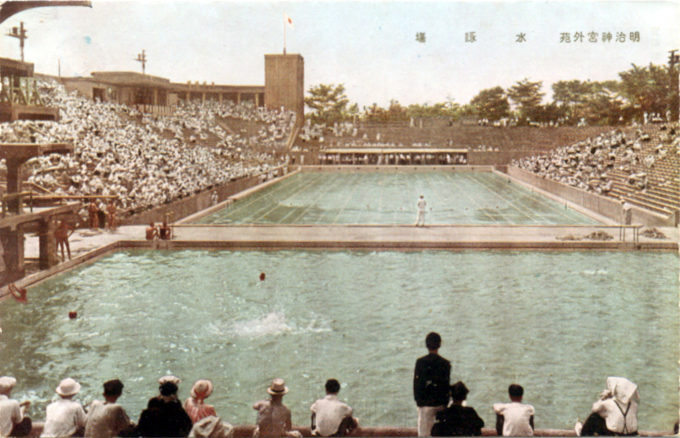
Meiji Jingu swimming pool, Setagaya, Tokyo, c. 1935. Constructed in 1931, the pool is divided into a section for aquatic races and another for diving.
See also:
Meiji Shrine Outer Garden under construction, c. 1925
Meiji Shrine Games, Tokyo, 1926
“As might be expected from the geographical position of Japan, swimming is one of her important outdoor sports that have been popular from time immemorial. The country is sea-girt, and has a wealth of rivers and streams that afford good swimming.
“… As early as the twelfth century, swimming was part of the military training sedulously pursued by warriors. In the days of the Tokugawa shoguns, swimming came to be regarded more as a ceremonial performance shown in the presence of a feudal lord than as a martial art. Thus, under the patronage of daimyos, different schools of swimming were founded by different masters of the art.
“… Demonstrations of trick swimming which is peculiar to Japan are given now and then in the Meiji Shrine Swimming Pool, Tokyo … Until about thirty years ago [ca. 1905] swimming contests in Japan meant display of skill in upright swimming and not competition in speed.”
– “What Makes the Japanese Good Swimmers”, by Ikkaku Matsuzawa, Travel in Japan, Summer 1935
“Tokyo is able to allot the outer precincts of the Meiji Shrine, situated amidst a picturesque and scenic location, as the central grounds for holding various branches of sport, which can well boast of being a far more ideal site than any of the other world-faed stadiums by having a stadium that can be used for track and field events, rugby, soccer and other similar forms of sport, with an accommodation of 60,000 persons, in addition to having a spacious baseball ground that can accommodate 55,000 people, and it is indeed astonishing to observe how large a number of spectators are attracted here to various forms of sport all the year round.
“Close by these are situated the clear and transparent Meiji Shrine swimming pool with an accommodating capacity of 15,000 and which is an ideal pool that anyone will readily acknowledge as being able to easily compare with that of Los Angeles where the previous [1932] Olympiad was held.”
– Glimpses of the East, Nippon Yusen Kaisha (NYK), 1935-1936


